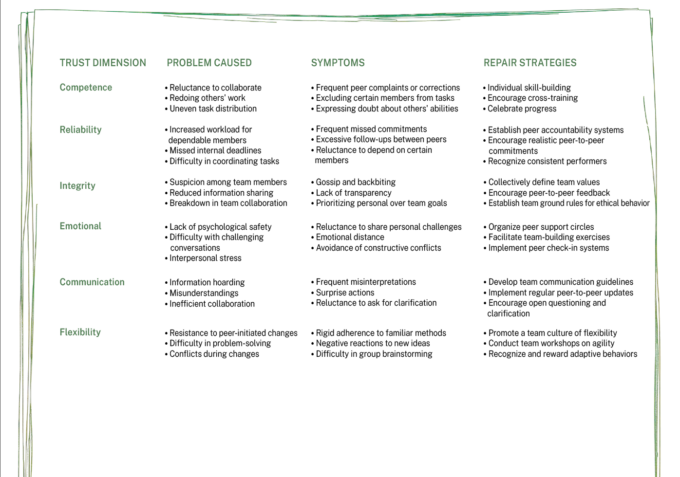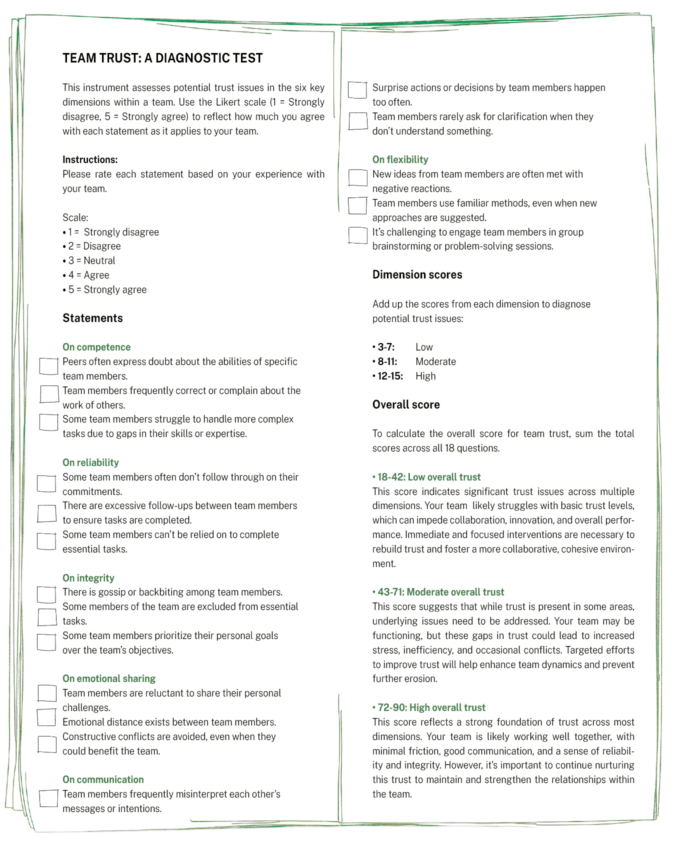IMD business school for management and leadership courses

Team building
How to heal teams driven apart by suspicion and mistrust
Published April 29, 2025 in Team building • 7 min read • 
Use this diagnostic tool and roadmap to rebuild trust and confidence within dysfunctional teams – the first crucial steps toward a future of high performance.
When Tony Banet stepped into his role as CEO of Especias Hispania’s North America division*, he inherited a team fractured by distrust. During the six-month leadership gap before his arrival, intense battles had erupted between marketing teams competing for resources to support new product launches. The previous CEO had created a cut-throat culture where individual success was all that mattered. This had resulted in what Banet described as “pervasive protectionism”. Team members focused on defending their territories instead of supporting collective success. Key executives played politics and withheld information, while marketing leaders engaged in constant turf wars. Even potential partners had withdrawn due to the toxic team dynamics.
Banet knew he would have to diagnose and repair these multifaceted problems before he could improve the team’s performance. New leaders often inherit teams with serious trust issues – not just isolated breakdowns between individuals but systemic problems that undermine performance.
Rebuilding trust is essential if you want to lead a high-performing team. However, this takes more than the usual leadership skills. You will first need to become an investigator to uncover and understand the sources of damage. Then, you need to be a healer to fix the foundations of trust.
Trust breakdowns can stem from many sources: we’ve all seen these play out and perhaps suffered the consequences. Your predecessor might have pitted team members against each other, as Banet discovered. Long-standing personality clashes may have created deep-seated tensions. Differing work styles may have resulted in chronic misunderstandings. Organizational changes like mergers or downsizing could have left the team insecure and defensive. A history of unmet expectations or past failures, whether from previous leadership or between team members, might have gradually taken its toll.
Your awareness of these issues and other trust deficits is the first step toward creating a more cohesive, high-performing group. Once you have a better idea of the nature of the problems, you can look to implement targeted strategies to address them, ultimately fostering an environment where trust can be rebuilt and strengthened over time.
These “repair” strategies take many forms and should be tailored to the types of trust breakdowns you face. For example, if there is unhealthy competition or personality clashes, you might engage the team in defining a shared set of values and rules for collaborative behavior. If there are many misunderstandings, consider establishing communication guidelines and encouraging a more open environment.
However, before you embark on this two-step process of diagnosis and repair, it’s important to understand the different kinds of trust that influence a team’s performance. Insight into the multidimensional nature of trust will empower you to apply the appropriate repair strategies, just as a doctor knows what medicine to prescribe for each ailment.

“Insight into the multidimensional nature of trust will empower you to apply the appropriate repair strategies, just as a doctor knows what medicine to prescribe for each ailment.”
The six dimensions of trust
Team trust is not a monolithic concept; it embodies many meanings and manifests itself in various forms: confidence in a colleague’s expertise, reliance on their word, faith in their intentions, willingness to show vulnerability, openness in sharing information, and adaptability to change.
To help clear a way through the fog, I have developed a framework for understanding, diagnosing, and repairing trust issues based on six key dimensions of trust.
- Competence: The belief that team members possess the necessary skills, knowledge, and expertise to perform their roles effectively.
- Reliability: Confidence that team members will consistently deliver on commitments, meet deadlines, and follow through on promises.
- Integrity: The conviction that team members will act ethically, honestly, and in alignment with shared values, including trust in the fairness of decision-making processes.
- Emotional: The expectation that team members will offer emotional support, empathy, and care for each other’s well-being, creating a safe environment for vulnerability and personal expression.
- Communication: The certainty that team members will communicate openly, transparently, and accurately, sharing important information in a timely and honest manner.
- Flexibility: Confidence that team members can be flexible and open to change when the situation demands it, willing to adjust their roles, behaviors, or strategies in response to new challenges or opportunities.
Problems and repair strategies
Let’s explore these six dimensions one by one (see table below) and examine how they show up in the workplace. What kinds of problems can emerge within your team based on the dimension of trust in question? What signs should you watch for? And what specific strategies can be implemented to restore trust in your team?

Diagnosis and repair
Diagnosing and repairing trust issues in teams in a way that builds lasting, robust trust requires a systematic and sustained approach, not just knowledge. It’s one thing to recognize specific trust problems and symptoms or to know a few appropriate repair strategies to ease tensions; it’s another prospect entirely to transform a fractured, underperforming team’s dynamics and results.
With this in mind, here is a seven-step roadmap to help you navigate the entire complex and sensitive process, from diagnosis and repair to monitoring and leadership.
- Conduct a comprehensive assessment. Begin by thoroughly assessing trust levels across all six dimensions. Use the “Team Trust Diagnostic Instrument” (see panel) supplemented with interviews and observations if feasible. Synthesize and analyze the data to get a complete picture of the team’s trust landscape.
- Analyze root causes. Once you’ve identified which trust dimensions are compromised, dig deeper to understand the root causes. Consider historical events, structural issues, individual behaviors, and external pressures that may have eroded trust. Use techniques like the “5 Whys” or fishbone diagrams to uncover the underlying problems.
- Establish your priorities. Not all trust issues can be addressed simultaneously. Prioritize based on the severity of the trust breach, its impact on team performance and well-being, the team’s readiness to address the issue, and available resources. Create a matrix to visualize and rank trust issues based on urgency and importance.
- Create an action plan. Develop your plan to address the prioritized trust issues. For each dimension, set clear objectives, select appropriate repair strategies, assign responsibilities, and establish timelines. Ensure that the plan addresses both short-term wins and long-term cultural changes.
- Role model trust. To foster trust, you must be trustworthy. Model trustworthy behavior, provide necessary resources, create a safe space for open dialogue, and align organizational systems to reinforce trust-building efforts. Consider bringing in external facilitators or coaches for severe trust breaches.
- Monitor and adjust. Trust-building is an ongoing process that requires constant attention. Regularly reassess trust levels, gather feedback on the effectiveness of implemented strategies, and be prepared to adjust the action plan as needed. Celebrate successes and implement a system for early detection of trust issues.
- Embed trust in your team culture. To sustain improvements, incorporate trust-building into onboarding and training programs, include trust metrics in performance evaluations, regularly discuss its importance, and recognize behaviors that exemplify the six dimensions of trust. Consider developing a “Trust Charter” that outlines the team’s commitment to maintaining high levels of trust.
By understanding the six dimensions of trust and employing a systematic approach that includes assessment, root cause analysis, and targeted intervention, you can rebuild and strengthen trust in your team.
Banet rebuilt trust by fostering communication, accountability, and collaboration. He encouraged open dialogue, reinforced shared goals, and ensured team members had clear roles and responsibilities. He helped shift the team’s mindset from competition to cooperation by promoting transparent communication and aligning incentives with collective success.
He also led by example, modeling trust and consistency in his actions while encouraging others to do the same. He facilitated conversations that addressed past tensions, established clear expectations, and created opportunities for cross-functional collaboration.
Although it took some time, these efforts improved relationships and team cohesion. Trust levels had visibly improved within months, and the team operated with greater alignment. Banet’s example illustrates that even in fractured teams, trust can be restored through deliberate cultural change, ultimately paving the way for high performance and long-term success.
Diagnosing and repairing trust issues within teams is a complex but essential process for fostering high performance and well-being. By understanding the six dimensions of trust and employing a systematic approach that includes assessment, root cause analysis, and targeted intervention, you can rebuild and strengthen trust in your team.
Keep in mind that trust is delicate and can be easily broken, but with consistent effort and commitment, it can also be repaired and reinforced. As teams navigate the challenges of modern work environments, those prioritizing trust-building will be better equipped to collaborate effectively, innovate, and achieve their goals.
Click here to take the Team Trust Diagnostic Test.
*Names have been changed to protect confidentiality.

Related

When it comes to trust, your actions speak louder than words
May 29, 2025 in Team building
Leadership When it comes to trust, your actions speak louder than words by Shelley Zalis Published 16 April 2025 in Leadership • 3 min read DownloadSave People don’t work for companies. They...
Audio available

Communication: let’s be clear, we should cut out the clichés
May 5, 2025 in Team building
The soulless language of management speak leads to uninspired and disengaged teams. Here’s how to sharpen your language skills to become a more effective leader....
Audio available

How to drive meaningful progress on DE&I, without sparking political resistance
April 9, 2025 in Team building
As corporate America adjusts to a shifting political environment under President Donald Trump, companies must rethink their approach to DEI. ...

Trust is like a dance. Learn the steps to be a better leader
April 3, 2025 in Team building
To waltz smoothly through office life, we need to balance vulnerability and honest feedback. And it’s perfectly fine to step on someone’s toes occasionally....
Audio available